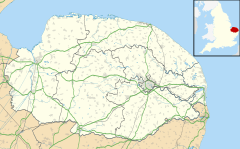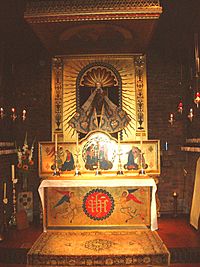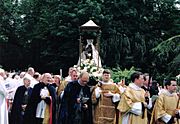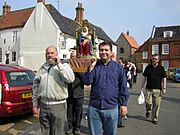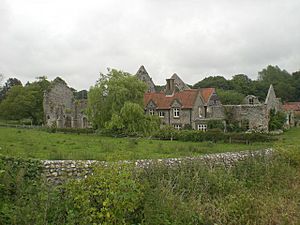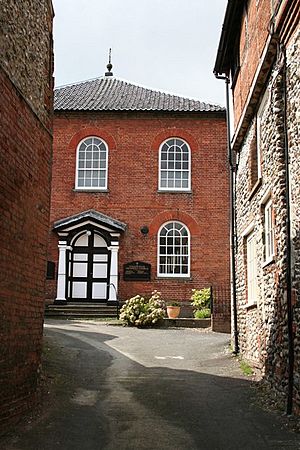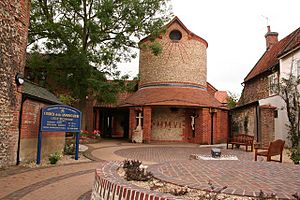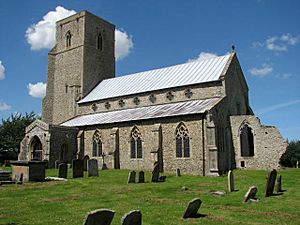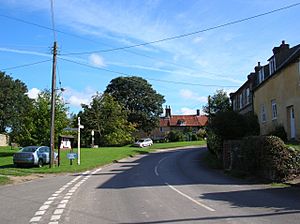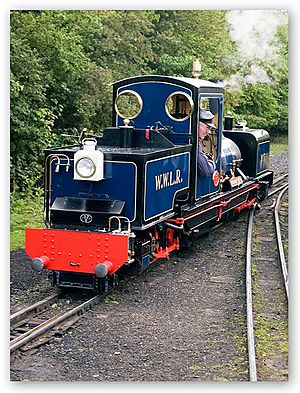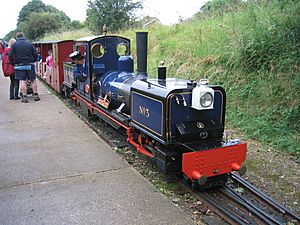Walsingham facts for kids
Quick facts for kids Walsingham |
|
|---|---|
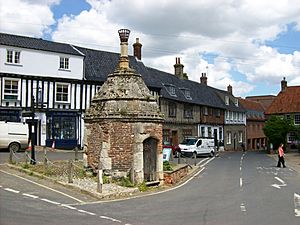 Common Place, Little Walsingham |
|
| Area | 18.98 km2 (7.33 sq mi) |
| Population | 819 (2011) |
| • Density | 43/km2 (110/sq mi) |
| OS grid reference | TF934368 |
| • London | 118 miles |
| Civil parish |
|
| District | |
| Shire county | |
| Region | |
| Country | England |
| Sovereign state | United Kingdom |
| Post town | WALSINGHAM |
| Postcode district | NR22 |
| Dialling code | 01328 |
| Police | Norfolk |
| Fire | Norfolk |
| Ambulance | East of England |
| EU Parliament | East of England |
| UK Parliament |
|
Walsingham is a small village in North Norfolk, England. It is very well known for its special religious shrines that honor the Virgin Mary. The village also has the old remains of two medieval monastic houses, which were homes for monks or nuns long ago. Walsingham is about 27 kilometers (17 miles) northwest of Norwich.
The area called the civil parish of Walsingham includes two main parts: Little Walsingham and Great Walsingham. It also includes Egmere, which was once a village but is now empty. The whole area covers about 18.98 square kilometers (7.33 square miles). In 2011, about 819 people lived here. The name Walsingham means "Homestead or village of Waels' people."
Contents
Walsingham: A Special Place for Pilgrims
Walsingham is a very important place for pilgrimage, which is a journey made for religious reasons. The story of Walsingham began in 1061. An Anglo-Saxon noblewoman named Richeldis de Faverches had a vision of the Virgin Mary. In this vision, Mary told her to build a copy of the house where the Holy Family lived in Nazareth. This was to honor the Annunciation, which is when the Angel Gabriel told Mary she would have Jesus.
When it was built, the Holy House in Walsingham was made of wood. Inside, there was a wooden statue of the Virgin Mary sitting on a throne, holding the child Jesus on her lap. One of its special relics was a small bottle said to contain the Virgin Mary's milk. Walsingham quickly became one of the most important pilgrimage sites in northern Europe. It stayed popular throughout the Middle Ages and saw a big return of pilgrims in the 20th century.
The Old Priory and Its History
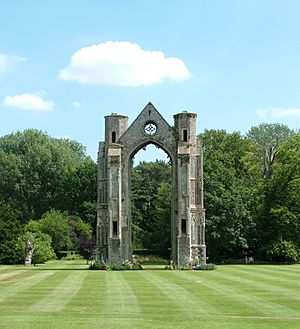
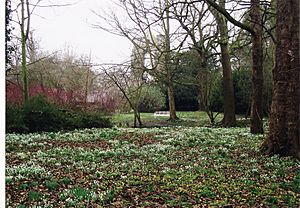
A priory was built here in 1153 for Canons Regular, who were a type of religious community. It was located a few miles from the sea in northern Norfolk and became more important over the centuries. The Chapel of Our Lady of Walsingham was founded around the time of Edward the Confessor. A century later, it was confirmed to the Augustinian Canons and became part of their priory.
From the very beginning, the shrine was famous. People came from all over England and Europe to visit it. This continued until King Henry VIII ordered the destruction of the priory in 1538. Even today, the main road used by pilgrims through Newmarket, Brandon, and Fakenham is still called the Palmers' (Pilgrims') Way.
The canons of Walsingham received many gifts, including land and money. Many people sought and claimed to have experienced miracles at the shrine. Several English kings visited, including Henry III, Edward I, Edward II, Edward III, Henry VI, Henry VII, and Henry VIII. It was Henry VIII who later caused its destruction during the Dissolution of the Monasteries.
Erasmus, a famous scholar, visited in 1511. He left Greek poems as an offering. Years later, he wrote about the great wealth and beauty of Walsingham. Two of Henry VIII's wives, Catherine of Aragon and Anne Boleyn, also made pilgrimages to the shrine.
In 1537, the last Prior (leader of the priory), Richard Vowell, was trying to please Thomas Cromwell, a powerful minister. However, the Sub-Prior, Nicholas Mileham, was accused of planning to rebel against the king's orders to close the smaller monasteries. With little proof, he was found guilty of treason and executed outside the Priory walls. Eleven people in total, including two singers who helped organize the revolt, were also severely punished.
What they feared happened the next year. In July, Prior Vowell agreed to the destruction of Walsingham Priory. He helped the king's officials remove the statue of Our Lady and many gold and silver items. For his cooperation, the Prior received a large yearly payment of 100 pounds. Fifteen other canons also received payments. With the shrine taken apart and the priory destroyed, Henry VIII sold the land to Thomas Sidney for 90 pounds. A private house was later built there. The gold and silver from the shrine were sent to London, and the statue of Mary and Jesus was burned.
The closing of the monastery led to a sad poem called The Walsingham Lament. This poem, written by someone unknown during the time of Queen Elizabeth I, shows how the people of Norfolk felt about losing their Shrine of Our Lady of Walsingham. The poem includes these lines:
- Weep, weep, O Walsingham,
- Whose days are nights,
- Blessings turned to blasphemies,
- Holy deeds to despites.
- Sin is where our Ladye sat,
- Heaven turned is to hell;
- Satan sits where Our Lord did sway,
- Walsingham, O farewell!
Walsingham's Comeback: Modern Pilgrimages
In 1897, Pope Leo XIII blessed a new statue for the old shrine of Our Lady of Walsingham. This statue was sent from Rome and placed in the Holy House Chapel at the new Roman Catholic church in King's Lynn. On August 20, 1897, the first pilgrimage since the Reformation took place. Pilgrims went to the Slipper Chapel at Walsingham. This chapel had been bought by Charlotte Boyd(e) in 1895 and restored for Catholic use. Hundreds of Catholics attended and promised to make this an annual pilgrimage.
In 1900, a caretaker was placed at the Priest's House near the Slipper Chapel. This helped Catholic pilgrims use the chapel, which was looked after by monks from Downside Abbey. The Catholic National Shrine at the Slipper Chapel was officially opened on August 19, 1934, with over 10,000 pilgrims present.
An Anglican Marian shrine was also started in Walsingham by Father Alfred Hope Patten, the Anglican vicar, in 1921. First, the image of Our Lady was placed in the parish church of St Mary and All Saints in 1922. Then, in 1931, it was moved to a special building built just for it. Pilgrimages now happen throughout the summer months.
The Anglican National Pilgrimage takes place on the Spring Bank Holiday. The Student Cross pilgrimage on Good Friday visits both the Anglican and Catholic shrines. The National Youth Pilgrimage is in the first week of August and also visits the Anglican shrine.
The Catholic shrine is still based at the Slipper Chapel, near Houghton St Giles. Many important events have been held here, including the Pilgrimage of Catholic Youth in 1938. In 1982, the statue of Our Lady of Walsingham was taken to Pope John Paul II at a special Mass in Wembley during his visit to Britain. In 2000, a new Feast of Our Lady of Walsingham was approved to be celebrated in England and Wales on September 24.
Walsingham has also seen opportunities for ecumenical cooperation, which means different Christian churches working together. There is a small Orthodox chapel in the Anglican shrine. The Orthodox presence has grown at the Church of the Holy Transfiguration, which used to be a Methodist chapel in Great Walsingham. They also have a church at the former Little Walsingham railway station, which is now the church of St Seraphim.
The Little Sisters of Jesus have a community of sisters in Little Walsingham since the late 1960s. There is also a community of Carmelites in the village.
Places of Worship in Walsingham
Little Walsingham
Shrines
- Anglican Shrine of Our Lady of Walsingham (Church of England)
- The Chantry Chapel of Saint Michael and the Holy Souls (Guild of All Souls)
- Chapel of the Life-Giving Spring of the Mother of God (Russian Orthodox)
Churches
- St Mary and All Saints (Church of England parish church)
- Church of the Annunciation (Roman Catholic parish church)
- Walsingham Methodist Chapel
- St Seraphim (Russian Orthodox church)
Monastic Ruins
- Walsingham Priory (St Mary's Priory, or ...Abbey) (Augustinian) - open to the public (fee)
- St Mary's Friary (Franciscan; the 'Greyfriars')
Great Walsingham
Churches
- St Peter (Church of England parish church)
- The Holy Transfiguration (Russian Orthodox parish church)
Church Ruin
- All Saints and St Mary (former parish church)
Houghton
Shrine
- Basilica of Our Lady of Walsingham (the "Slipper Chapel") (Roman Catholic National Shrine)
- Chapel of Reconciliation (Roman Catholic)
Church
- St Giles (Church of England parish church)
Egmere
Church Ruin
- St Edmund (former parish church)
Nearby
About 4 kilometers (2.5 miles) to the northeast is Binham Priory.
Walsingham's Geography and Landscape
The village of Walsingham is actually two older settlements that have joined together: Great Walsingham and Little Walsingham.
In the 1800s, Little Walsingham was described as a small town, sometimes called Walsingham or New Walsingham. Great Walsingham was a smaller, separate village, sometimes called Old Walsingham. A market that used to be held on Tuesdays was no longer active by 1845. The Friday market was already small in 1845 and had stopped by 1883.
The River Stiffkey flows through the area from south to north, passing east of the main part of the village. The center of Little Walsingham is about 17 meters (56 feet) above sea level. It lies in the Stiffkey valley, with the land rising to the east and west. To the west, it rises to about 75 meters (246 feet) at Egmere. National Cycle Route 1 also passes through the village.
The former North Creake airfield is located within the parish, just north of Egmere. This area, known as Bunker's Hill, is now used for businesses and industry since the airfield is no longer in use.
How Walsingham is Governed
Walsingham has a parish council, which holds its meetings at the Village Hall. The parish is divided into Great and Little wards, which are based on the two former civil parishes that merged.
There is also a ward called Walsingham, which elects one councilor to the North Norfolk District Council. The current councilor is Tom FitzPatrick. In 2011, this ward had a population of 2,167. Since 2019, the ward includes the parishes of Barsham, Great Snoring, Little Snoring, Sculthorpe, and Walsingham.
From 1894 to 1974, the Walsingham Rural District existed, though its council was based in Fakenham.
The Shirehall on Common Place was used as a courtroom until 1974. Today, this building is a museum and belongs to the Walsingham Estate. The village has another museum building, which used to be a prison called the House of Correction, or The Bridewell.
Egmere and Quarles were combined into the civil parish of Great Walsingham in 1935. However, Quarles later moved to Holkham in 1947.
For religious matters, Walsingham is part of the Church of England diocese of Norwich and the Roman Catholic Diocese of East Anglia.
Getting Around Walsingham
Wells and Walsingham Light Railway
Walsingham used to be connected to the national railway system. It was on the Wymondham to Wells Branch line. However, this line was closed in stages between 1964 and 1969 as part of the Beeching Axe, which closed many railway lines in Britain.
In 1979, work began to build a special heritage railway on the old track bed. This railway uses a narrow gauge of 10.25 inches and goes to Wells. The line reopened in 1982 and now runs with a fleet of small steam and diesel locomotives.
A new station was built in Walsingham for this heritage railway. The old station building, with its platform still visible, is now Saint Seraphim's Orthodox church.
Public Transport
Walsingham has a regular bus service. It is on the Coastliner bus route (service number 36). You can take this bus to places like Fakenham, Wells, Hunstanton, and King's Lynn.
Other Places Named Walsingham
- Walsingham, Ontario, Canada
- Walsingham, Canterbury, New Zealand
- Walsingham — and Walsingham Bay — in Hamilton, Bermuda
- Walsingham House School, South Bombay, India.
See also
 In Spanish: Walsingham para niños
In Spanish: Walsingham para niños


